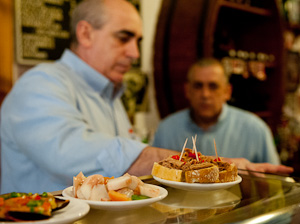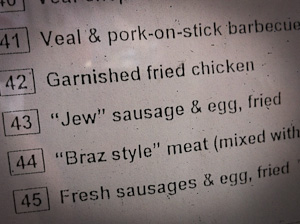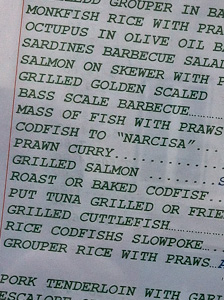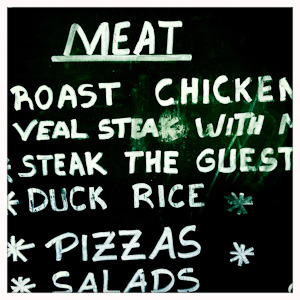Just give me the REAL menu
I’m a good tourist, and I don’t automatically expect everyone to speak English. I learn at least a few phrases, no matter where I’m going – just enough to order a meal, say please and thank you – the basics. If the phrasebook in my pocket doesn’t get me out of trouble, I use sign language. Or I point and smile. Maybe I’ve fooled myself into believing that people treat me better if I make an effort, but people are generally nice to me wherever I go, so I’m not looking to mess with this formula.
Before I arrive someplace new, I’ve probably read a little about what’s there, where to go, what to eat and drink. My dining motto, especially while travelling, has always been “don’t order anything stupid.” I’m sure you know what I mean. The moment something arrives in front of you, you will know whether it was stupid or not. For example, you should have seafood or Italian in Boston. Wurst in Germany. BBQ in Texas. I know not to order pastrami in South Dakota (it will come cold, on white bread, with Miracle Whip). I would never order a taco in Maine. Or sushi in Omaha.
Being prepared has served me well  for a lot of years, armed with a little knowledge about what to order, and how to order it. But something funny is going on. As more and more people travel, English has become the default lingua franca for travellers between two unrelated nations. When a Danish tourist goes into a Spanish restaurant, you’re more likely to hear the dialog in English than anything else. So now English menus are foisted upon anyone who looks like they’re “not from around here.” And this is where I’m having a problem.
for a lot of years, armed with a little knowledge about what to order, and how to order it. But something funny is going on. As more and more people travel, English has become the default lingua franca for travellers between two unrelated nations. When a Danish tourist goes into a Spanish restaurant, you’re more likely to hear the dialog in English than anything else. So now English menus are foisted upon anyone who looks like they’re “not from around here.” And this is where I’m having a problem.
When you go to Italy, you would expect to find spaghetti on the menu. But if a bad English menu translation described it as “flaccid str ands of boiled wheat paste, served with pan-fried globes of minced cow flesh,” you’d be annoyed and disgusted, right? Just call it spaghetti. I can figure it out.
ands of boiled wheat paste, served with pan-fried globes of minced cow flesh,” you’d be annoyed and disgusted, right? Just call it spaghetti. I can figure it out.
My mistrust of menu translations began a few years back, when browsing an American menu reader for British people, and I actually saw an enchilada described as a “cornmeal crêpe, stuffed with savoury fillings, with a capiscum cheese sauce.” I wondered about those poor souls who came to Albuquerque looking for an enchilada, but couldn’t recognize it from the horrible translation.
When I visited China in 2008, I had a hankering for Chinese greens (bok choy, snow pea leaves – anything green). I asked in Changlish if they had something like that, beca use the only thing remotely green on the menu was “Fried Lettuce.” They said “Sorry – no greens. We have Lettuce.” So I gave up. A few minutes later, the next table got a nice plate of snow pea leaves with garlic! So I asked the waiter “what is that?” and he replied “Lettuce.” This is when I realized the world has a growing and serious problem with bad menu translations.
use the only thing remotely green on the menu was “Fried Lettuce.” They said “Sorry – no greens. We have Lettuce.” So I gave up. A few minutes later, the next table got a nice plate of snow pea leaves with garlic! So I asked the waiter “what is that?” and he replied “Lettuce.” This is when I realized the world has a growing and serious problem with bad menu translations.
Granted – I wouldn’t have known the Chinese word for greens anyway. But when I go to France, I expect to see a crêpe called a crêpe. Not a frickin’ pancake. I don’t need a translation for crêpe. When I go to Italy, I want to see ravioli on the menu. I don’t need an English menu that calls them “cheese pockets.”
So last week, I had to beg for the Portuguese menu several times. I’d read about Lisbon’s garlic sausage called Alheira, but that name was not to be found on the English menu. Instead, the English menu lists it as “Jew Sausage.” OK then!
Another restaurant had a nice “Head to Rump Steak.” Nope. Not sure I can eat a whole cow.
Care fo r some “Rice Codfish Slowpoke?” Sorry, I don’t have all night.
r some “Rice Codfish Slowpoke?” Sorry, I don’t have all night.
The “Grilled Golden Scaled” is lovely this evening. Golden scaled what?
Or maybe the “Mass of Fish with Praws.” Nay. I avoid dishes that have the word mass in them.
And then there’s “Steak the Guest.” Oops – I need to leave now. I forgot my wallet.
I’m sorry. I don’t mean to be cranky. I know your intentions are good, and I really am trying to be a good tourist. But just give me the Portuguese menu, dammit. I’ll look it up myself.


